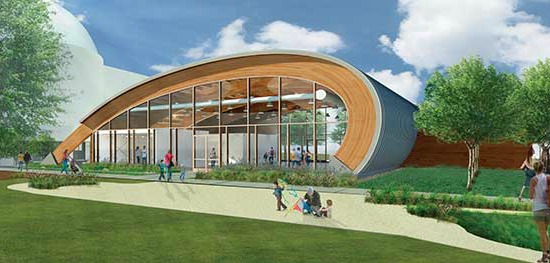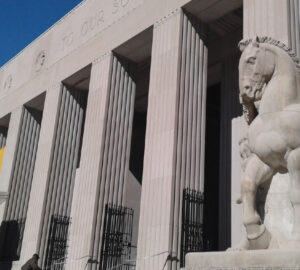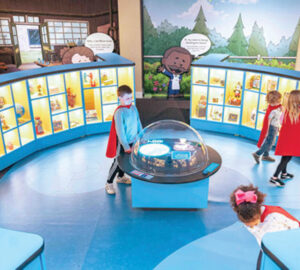st. louis
The journey our food takes from field to table is whimsically and well told through ‘GROW,’ a new permanent exhibit at the Saint Louis Science Center (pictured above) in Forest Park. (Emphasis is not on the journey it makes from mouth to intestine, because that would be alimentary.) The jam-packed, multifaceted presentation first answers simple questions as it examines the most important element of our daily lives other than smart phones: our food. Where does it come from? How does it grow? How far does it travel? Then it poses a more important one to a planet facing so much hunger: How can each of us make a difference so we can all eat? As the Science Center contends, we all have a role to play in the stewardship of our food supply. Over an acre in area, the exhibit is the size of a very, very small farm or maybe as big as an average farmer’s market. With its central feature a Gyo Obata-designed pavilion, inside and out are interactive features with names such as ‘water works,’ ‘botany basics’ and ‘fermentation station.’ Yes, you may re-learn the difference between a stamen and pistil, but you’ll walk away thinking about how important it is to live sustainably. Always wanted a backyard garden but were never sure how to start in such a limited space? Learn how here. You can try your hand(s) at milking a life-sized cow and compare it to the technology that is widely used today. And you may even get to meet a real one. City and suburban kids of all ages will enjoy it when farmers come to visit, bringing livestock with them.
bridgeton
 Lambert-St. Louis International Airport is no more. Our airport, located north of the city in Bridgeton and environs, hasn’t relocated, but it is changing its name. To what ‘those in the know’ believe will be more traveler-friendly, for some reason: St. Louis International Airport at Lambert Field. I could see how some folks who’ve never visited our fair city might wonder whether the Lambert in the former name was another municipality, as St. Paul is to Minneapolis and Fort Worth is to Dallas. Or something like that. But that would give short shrift to a man responsible for transforming farmland into an airfield and who, in his day, was an aviation giant as noteworthy as Charles Lindbergh, only the latter gained forever fame by flying across the Atlantic Ocean from New York to Paris. We’d wager most St. Louisans above the age of, say, 12 know who Lindbergh was. But reportedly less than 20 percent know of the man with the surname Lambert who learned to fly with a pair of brothers surnamed Wright. Or that he lured Lindbergh to The Lou for air races here, where the famous aviator decided to stay on as a flight instructor. Or, and count me among them, what the rest of his name was: Albert Bond Lambert. Lambert’s graded and drained acreage was eventually paved, of course, and as the 20th century unfolded, became an epicenter of aircraft, (later spacecraft) manufacturing. (Does the name McDonnell ring a bell?) Editor’s note: Copy editors at publications throughout the metro will be hard-pressed to let anything other than ‘Lambert-St. Louis’ slip through their itchy little keyboard fingers. Maybe the hyphen made it stick for so long. That said, how long will it be before ‘…at Lambert Field’ drops off, never to be seen or heard again? No wonder Lambert’s descendants are wary.
Lambert-St. Louis International Airport is no more. Our airport, located north of the city in Bridgeton and environs, hasn’t relocated, but it is changing its name. To what ‘those in the know’ believe will be more traveler-friendly, for some reason: St. Louis International Airport at Lambert Field. I could see how some folks who’ve never visited our fair city might wonder whether the Lambert in the former name was another municipality, as St. Paul is to Minneapolis and Fort Worth is to Dallas. Or something like that. But that would give short shrift to a man responsible for transforming farmland into an airfield and who, in his day, was an aviation giant as noteworthy as Charles Lindbergh, only the latter gained forever fame by flying across the Atlantic Ocean from New York to Paris. We’d wager most St. Louisans above the age of, say, 12 know who Lindbergh was. But reportedly less than 20 percent know of the man with the surname Lambert who learned to fly with a pair of brothers surnamed Wright. Or that he lured Lindbergh to The Lou for air races here, where the famous aviator decided to stay on as a flight instructor. Or, and count me among them, what the rest of his name was: Albert Bond Lambert. Lambert’s graded and drained acreage was eventually paved, of course, and as the 20th century unfolded, became an epicenter of aircraft, (later spacecraft) manufacturing. (Does the name McDonnell ring a bell?) Editor’s note: Copy editors at publications throughout the metro will be hard-pressed to let anything other than ‘Lambert-St. Louis’ slip through their itchy little keyboard fingers. Maybe the hyphen made it stick for so long. That said, how long will it be before ‘…at Lambert Field’ drops off, never to be seen or heard again? No wonder Lambert’s descendants are wary.
chesterfield
You might have needed a kayak to get out of the Dillard’s department store at Chesterfield Mall a couple of weeks ago, but last time we checked, they don’t sell kayaks there. A water main busted, flooding the top floor, and flowing throughout to muck things up, there and on the lower two levels. (Amazingly, we hear, no other stores were seriously affected.) Firefighters were able to stem the flow, but lord knows after how many gallons poured into the store on a Wednesday about 9:30 a.m. A Dillard’s veteran says most workers on the morning shift probably would have arrived just about then, and one shot from TV news video showed employees milling around outside. Another shot showed water gushing out of side doors. There was no word from the company on when the store would be able to reopen, or what workers would do in the interim. (Look at laundry instructions on wet merchandise?) There are several other Dillard’s locations in the metro, and maybe they could accommodate a few extra people while the mess is cleaned up. But that’s just speculation. No one answered the phone at the store a few days after the epic flood, and the least we’d expect from upper management is an outgoing message letting curious and oblivious customers know that the store would be closed indefinitely and, meanwhile, recommend shoppers visit the Galleria or some other Dillard’s store. Alas, we let the Chesterfield Dillard’s phone ring at least 20 times and … nothing.
clayton
 Centene marches on. So far, Clayton has been marching to the same drummer, since plans for the managed-care provider’s ambitious downtown expansion plans recently got a nod from the city’s planning commission. But it wasn’t a slam-dunk: There may not be as many street-spanning skywalks as originally proposed. The four-‘subdistrict’ plan, much of which includes what has for so long been affectionately called the ‘Clayton hole,’ goes before the Board of Aldermen next. Of late, the company purchased the retail spaces on the street level in The Crescent condo complex, which company officials say should lend it more continuity as its plans start to unfold. Retail outlets now range from a coffee shop and restaurant to a bank and fitness center. (And, natch, a nail salon.) Meanwhile, some condo residents are miffed, contending the plan as it stands will impact everything from traffic to the choice views across the toney city’s skyline from their vantage point ‘down the hill’ on Carondelet Plaza. Indeed, with 2,000-some brand-new positions at Centene, there could be that much more rush-hour traffic on streets that are snarled enough. Most of the cars should be late-model, though, since the average Centene position will command $70,000 or so. And, if what the Fortune 500 company has already built in Clayton is any indication, the architecture will be intriguing. Treatment on the exterior of an existing building (Forsyth and Hanley) positively shimmers. It was named Best New Building in 2011 by our friends at the RFT. Going forward: One rendering of the proposed 1,000-seat auditorium shows a green (planted) roof.
Centene marches on. So far, Clayton has been marching to the same drummer, since plans for the managed-care provider’s ambitious downtown expansion plans recently got a nod from the city’s planning commission. But it wasn’t a slam-dunk: There may not be as many street-spanning skywalks as originally proposed. The four-‘subdistrict’ plan, much of which includes what has for so long been affectionately called the ‘Clayton hole,’ goes before the Board of Aldermen next. Of late, the company purchased the retail spaces on the street level in The Crescent condo complex, which company officials say should lend it more continuity as its plans start to unfold. Retail outlets now range from a coffee shop and restaurant to a bank and fitness center. (And, natch, a nail salon.) Meanwhile, some condo residents are miffed, contending the plan as it stands will impact everything from traffic to the choice views across the toney city’s skyline from their vantage point ‘down the hill’ on Carondelet Plaza. Indeed, with 2,000-some brand-new positions at Centene, there could be that much more rush-hour traffic on streets that are snarled enough. Most of the cars should be late-model, though, since the average Centene position will command $70,000 or so. And, if what the Fortune 500 company has already built in Clayton is any indication, the architecture will be intriguing. Treatment on the exterior of an existing building (Forsyth and Hanley) positively shimmers. It was named Best New Building in 2011 by our friends at the RFT. Going forward: One rendering of the proposed 1,000-seat auditorium shows a green (planted) roof.
university city
The Loop Trolley system is looking more and more like an honest-to-goodness transit system, beyond those anachronistic tracks in the street on Delmar Boulevard and beyond, on the way to a southeast terminus at the History Museum in Forest Park. Wires are going up on poles. That’s right, the system will run on electricity, just like MetroLink and many other light-rail and subway systems do around the country. No diesel fumes here. While workers install the overhead wires, detours will be necessary here and there throughout the process. By the time you read this, wire work is expected to have been completed at the Delmar-DeBaliviere intersection and begun from the end of the line up DeBaliviere. Anticipated completion for that was today, but keep your eyes peeled. Important: The trolley wire is a high-voltage (600 volts), non-insulated electrical system similar to MetroLink’s, and will provide power for the trolley along the entire route. All along, the wire will be fixed at a height that will not allow contact with pedestrians or normal traffic. But to prevent serious injury … or much, much worse … people and objects must stay at least 10 feet away from the wires and avoid coming in contact with the trolley poles. How positively early 20th-century! In a few months, and especially when the trolley starts operating next year, all that will be missing from a Delmar Loop streetscape will be autos the vintage of Model Ts and hats on pedestrians—like flat-topped straw boaters in the summer.








